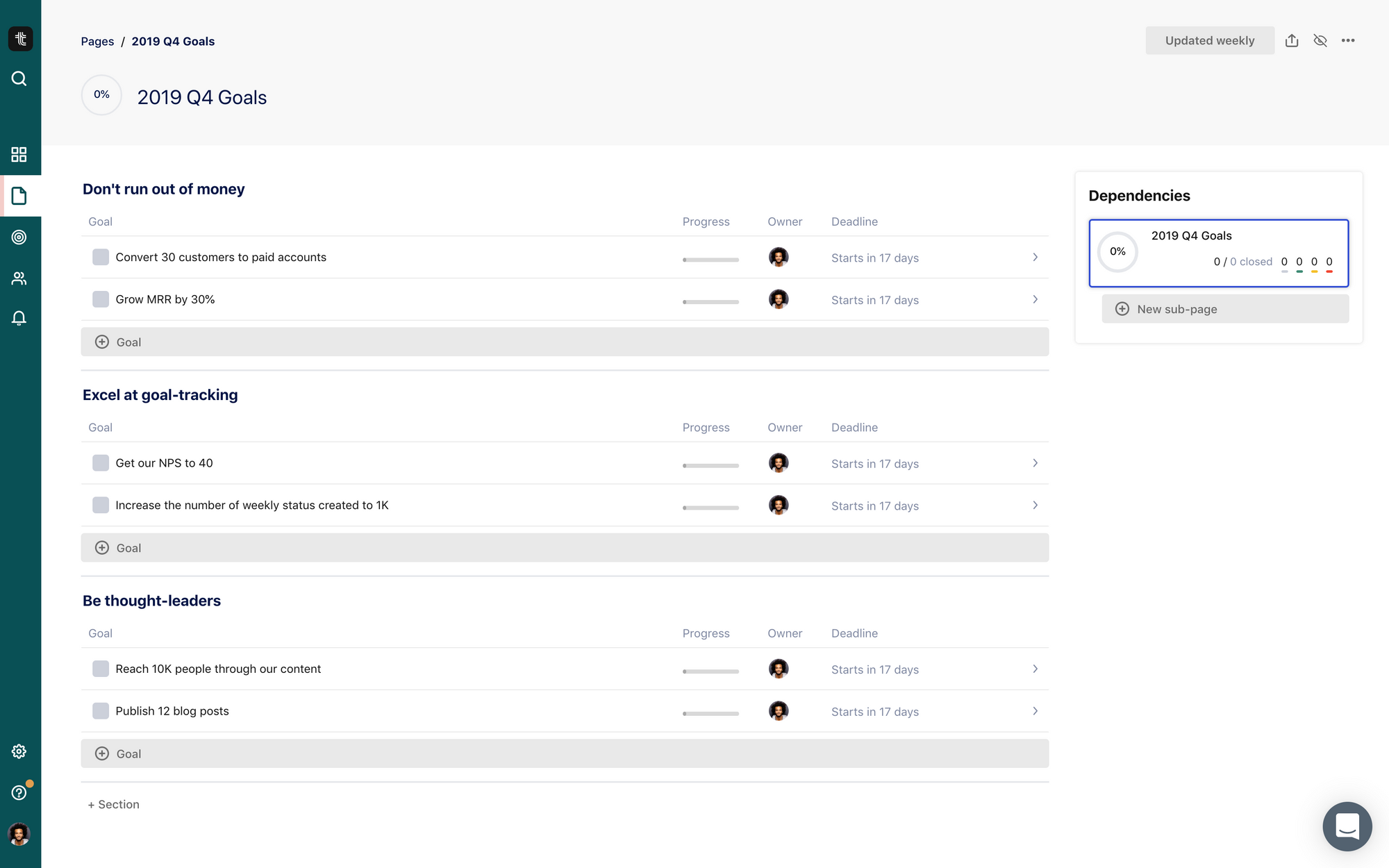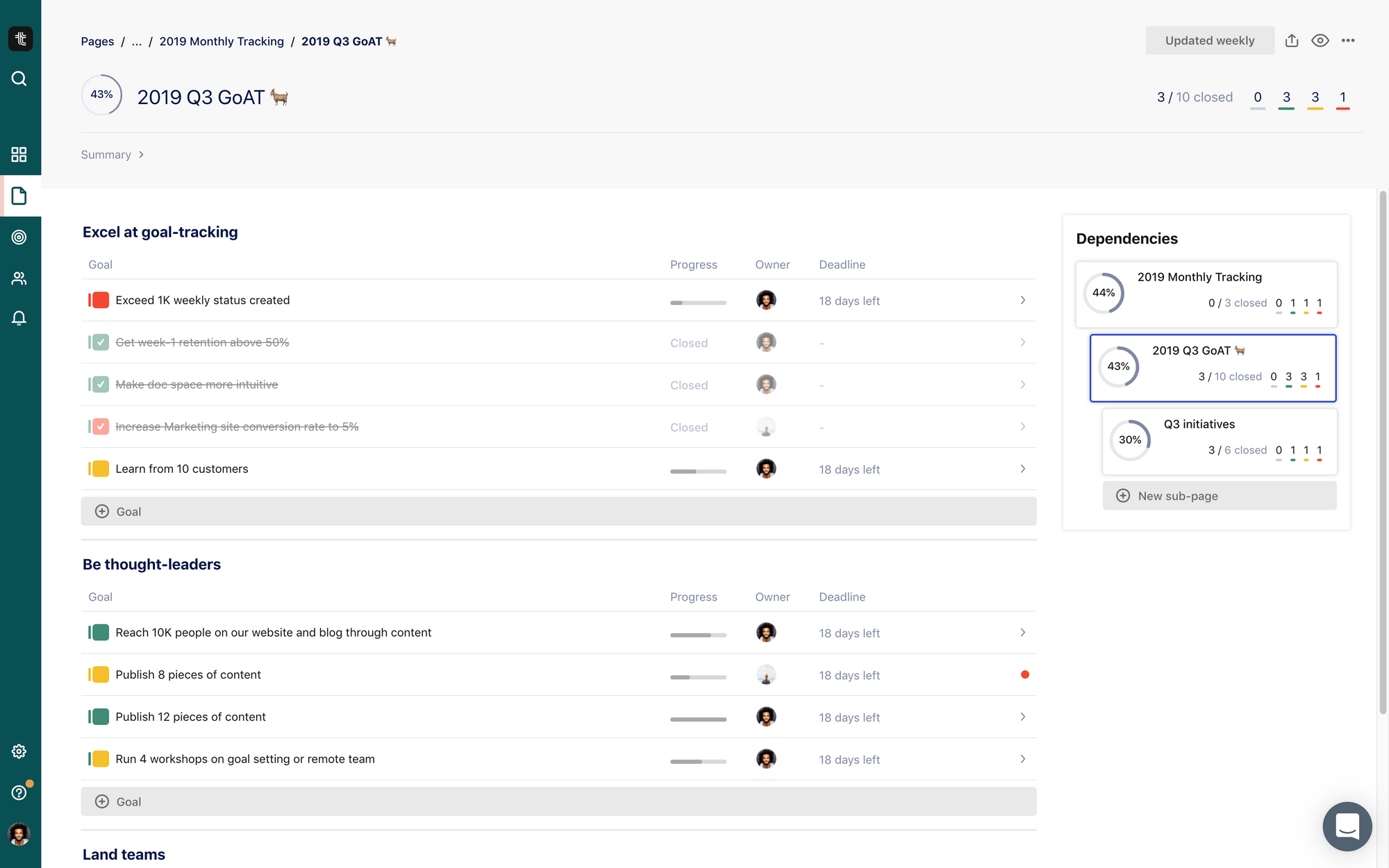How we use Tability to build... Tability
"Eat your own dog food!" — Using Tability is about much more than testing our own product. It's what keeps us focused and flexible.

Yesterday was exciting as our little team made the news in Australia 🎉. It's a great occasion to talk about how we've been using our platform to stay focused and grow.
Even if you're not a user of Tability, I'm hoping that you'll find some good advice that you can apply with your own tools.
How we work
Our process is rather dull:
- Define focus areas for the quarter: what should we invest in?
- List some desired outcomes: what does success look like?
- Iterate on projects and outcomes: are we getting there?
We try to keep things as lean as possible. The difference is not in the way we plan — it's in how we execute on our strategy.
A lot of teams have the following approach to their quarter.

First, you plan. Then, you do monthly check-ins. Finally, there's a wrap-up meeting where you discuss how things went and how you can improve.
I'm not saying this doesn't work. But you only have 2 opportunities to check progress. It makes it hard to understand what's going on, and puts a lot of pressure on teams to get their review meetings right.
Now, here's what things look like for us.

It's all the same, except that we review progress on our strategy every week. And I'm not talking about checking features and code — most organizations are great at tracking deliverables. I'm talking about looking at the impact that our work has on our customers.
We're good at Product, but we make a lot of mistakes in Marketing and Sales. It still works out because we compensate our lack of brilliance by an ability to learn fast. Thanks to our rapid cycles, we can eliminate bad ideas early, and double-down on what works.
Weekly reviews help us be more focused and agile, and Tability is at the center of it.
Week 1: Planning
I'm not going to spend too much time on the planning part as we have several posts on the topic. But here are a few rules we go by:
1. Focus areas matter more than metrics
Time and time again we picked the wrong KPIs or got flakey data. That's why we spend more time discussing the What and the Why. It makes it easier to see when we're using bad metrics.
For instance, we stopped tracking retention mid-quarter. We realized that our analytic tool was giving us a blended cohort, which made the metric hardly relevant (it would always go up, to the right). Still, we kept working on retention improvements — we simply relied on other data points to check progress.
2. Not more than 10 weekly goals/person max
The more goals you have, the harder it is to focus. 10 is already a big stretch, and we're trying to keep the number of goals/person around 5-8. If you're using OKRs, the equivalent would be to make sure that no one has more than 10 Key Results attached to them.
Have fewer goals for more impact.
3. List your best bets
Our themes for Q3 were:
- Don't run out of money: land customers, increase revenue and be profitable.
- Excel at goal-tracking: keep improving the platform, focus on the goal-tracking part.
- Be thought-leaders: provide value beyond the product, and help teams be more outcome-driven.
We put those in a table along with success metrics. Then we looked at our backlog and brainstormed a list of possible projects. Having a list of possible bets is not about committing to all of them, it's about bringing things back to reality. It's good to map outcomes to possible activities to make sure that we're shooting for realistic targets.
Week 2-11: Execution

Once we have a clear plan, we add it to Tability.
- We create a new page for the quarter.
- We add sections for each of the focus areas.
- We add goals for the success metrics and some of the strategic projects.
We never put features in there. Anything that takes less than 2 weeks to ship is considered a roadmap item and goes to Trello. Tability is for outcomes and high impact projects.
Outcomes first, then activities
Every Monday at 8am I get a Slack reminder to share progress on my goals.

I could update my goals from Slack, but I like to go to Tability because I can read my past updates and see trends in the progress chart.

When I write an update, I try to answer 3 questions:
- Where are we today (metric value)?
- Is this what we expected?
- Should we do something differently?
The last question is the most important one. I don't go in panic mode the first time something gets off-track, but it's good to think about the meaning of the trends I observe.
On Tuesday morning, I sync with Bryan (co-founder). He lives in Portland so a lot of our entire collaboration is remote.
We start by looking at the goals to get a clear idea of how the quarter is doing.

It's only after doing our assessment that we look at the roadmap. If things are good, we keep going. But it some of the goals have been red for a few weeks, then we look at changing priorities.
Having this process helps us make the strategy more agile. It also makes remote collaboration easier as it focuses the discussion on purpose and impact.
Week 12: wrap-up
Closing the quarter is quite easy to do thanks to the regular check-ins. It's more an occasion to celebrate the wins, and look back in details at the things that did not work.
Then we start the new quarter!
Fast feedback makes you flexible
A key benefit of Tability is that it helps you stay focused. It doesn't matter if I went on a holiday, or if the kids did not let me sleep — I'll get a reminder on Monday to kickstart the week.
But what's truly great about the platform is that it helps us move faster. We're able to check on our bets early, and we can quickly adapt if needed. Focus and accountability is our secret sauce.
Don't hesitate to reach out if you have questions about the features or how we work. You can find me on Twitter at @stenpittet, and you can learn more about the features on our website.

